|
Ye Olde Apothecary
by Bob
Brooke
The Creole-style
townhouse at 514 Chartres Street in the heart of New Orleans's French
Quarter looks similar to its neighbors, with a windowed storefront
through which visitors to the Big Easy often stop to peer into a world
of long ago—a world of old counters and shelves overflowing with bizarre
instruments and bottles with strange labels. This is the New Orleans
Pharmacy Museum, also known as La Pharmacie Francaise, an 1850s
apothecary shop.
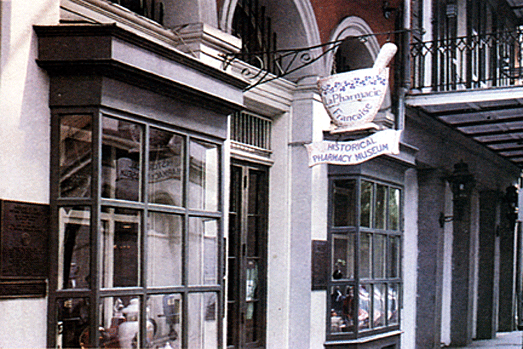
The museum building, constructed in 1823 by America's first licensed
pharmacist, Louis J. Dufilho, Jr., originally housed his shop and
residence. Because Louisiana was the first state to adopt a U.S.
pharmacy law, historians believe this shop to be the first pharmacy in
the country run by a licensed pharmacist.
.
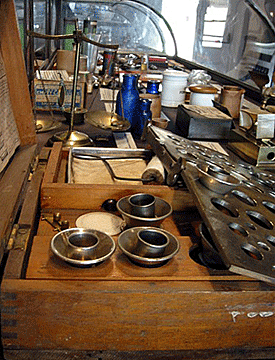 The
museum opened in 1950 to offer visitors a better understanding of
Louisiana's 19th-century health care. Its collection features 3,000
articles, from the ordinary to the bizarre, including live leeches,
pre-Civil War syringes and catheters, and cupping jars. Outside in the
courtyard a garden, filled with medicinal plants such as ginger and
althea and herbs such as basil and oregano, flourishes. The
museum opened in 1950 to offer visitors a better understanding of
Louisiana's 19th-century health care. Its collection features 3,000
articles, from the ordinary to the bizarre, including live leeches,
pre-Civil War syringes and catheters, and cupping jars. Outside in the
courtyard a garden, filled with medicinal plants such as ginger and
althea and herbs such as basil and oregano, flourishes.
Dufilho’s most significant contribution to the history and integrity of
the field of pharmacy occurred in New Orleans in 1816. In 1804, the
State of Louisiana, led by Governor Claiborne, passed a law that
required a licensing examination for pharmacists wishing to practice
their profession.
Prior to this law and before Louisiana became a U.S. State, there were
some informal territory licensing measures, but the state government
enforced none of them. A person could apprentice for six months and
afterwards compound and sell his or her own concoctions without any
regulations or standards. As a result, the unsuspecting public received
incorrect doses and erroneous medications. In 1804, Governor Claiborne
established a board of reputable pharmacists and physicians to
administer a three-hour oral examination given at the Cabildo in Jackson
Square.
Dufilho was the first to pass the licensing examination, therefore
making his pharmacy the first United States apothecary shop to be
operated on the basis of proven adequacy.
The Pharmacy
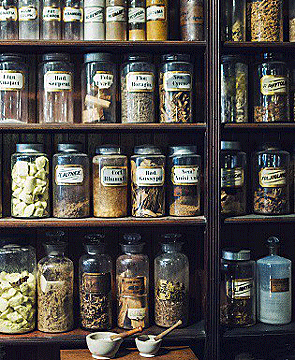 The
pharmacy part of the museum occupies the first floor of the town house.
Visitors can take tours which explain how doctors and others used the
various devices on display. Hand-blown apothecary bottles filled with
crude drugs, medicinal herbs, “gris-gris” potions used by Voodoo
practitioners and rare patent medicines speak of a time when pharmacists
compounded their own medicines and modern medical theory was in its
infancy. The
pharmacy part of the museum occupies the first floor of the town house.
Visitors can take tours which explain how doctors and others used the
various devices on display. Hand-blown apothecary bottles filled with
crude drugs, medicinal herbs, “gris-gris” potions used by Voodoo
practitioners and rare patent medicines speak of a time when pharmacists
compounded their own medicines and modern medical theory was in its
infancy.
The medicinal side of the shop features a large Victorian mirror and
shelves that act as a screen for the pharmacist’s work area. Jars of
natural herbs fill beautiful rosewood shelves. Behind the screen stands
a complete work cabinet with scales and typewriter, and a glass tile on
which to mix ointments and powders, and drawers filled with various
sizes of empty bottles, much like in pharmacies today. And on the
counter sits a huge marble mortar and pestle, the pharmacist’s primary
piece of equipment which he used to grind up herbs and such to make
medicinal compounds. Unlike today’s pharmacies that store prescriptions
in a computer, he stored his in a large cloth-bound book.
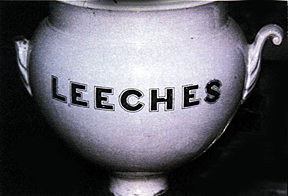 But
what makes this museum really unique is its collection of early
medicinal remedies. For example, leeches, dispensed by the pharmacist,
helped doctors and barbers, who did most of the bloodletting, to liquefy
coagulated blood of patients' dismembered limbs. They’re still used in
hospitals today for similar purposes. Cupping jars lowered patients'
blood pressure by drawing their blood through their skin into the jar. But
what makes this museum really unique is its collection of early
medicinal remedies. For example, leeches, dispensed by the pharmacist,
helped doctors and barbers, who did most of the bloodletting, to liquefy
coagulated blood of patients' dismembered limbs. They’re still used in
hospitals today for similar purposes. Cupping jars lowered patients'
blood pressure by drawing their blood through their skin into the jar.
In addition, there are jars of kerosene, used in treating snake bite and
for making kerosene “candy” by soaking a teaspoonful of sugar with it.
Taken nightly, this supposedly treated the common cold. There was also
cornsilk tea, a diuretic for treating heart failure. Plus, cooked okra
for alcohol withdrawal, fresh strawberry leaves, eaten in salad, for
treating anemia, and tonic bitters, with 21 percent alcohol. If a remedy
didn’t kill the patient first, it may have somehow relieved annoying
symptoms.
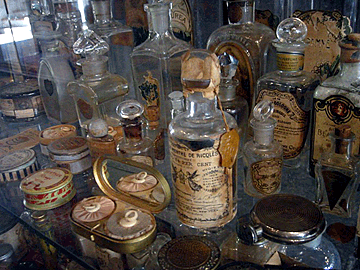 While
its common today to buy over-the-counter medicines in drug and discount
stores and even supermarkets, early pharmacists like Dufilho often
compounded them from crude drugs extracted from plant materials. Dufilho
also made his own pills and cut each one into an appropriate size, as
well as molded his own suppositories. While
its common today to buy over-the-counter medicines in drug and discount
stores and even supermarkets, early pharmacists like Dufilho often
compounded them from crude drugs extracted from plant materials. Dufilho
also made his own pills and cut each one into an appropriate size, as
well as molded his own suppositories.
Other Parts of the Pharmacy
Another feature of the shop is its 1855 Italian black-and-rose marble
soda fountain. Visitors, often puzzled as to why it’s there, learn that
it was because pharmacists knew the chemistry required to generate gas
for carbonated water. They would mix phosphates and flavorings with
bitter tasting medicines to make them more palatable. Eventually
customers wanted the drinks without the medicine, resulting in the
development of soft drinks. They used crushed ice and salt to cool the
carbonated soda, creating nectar soda and fruit phosphates for
customers.
The pharmacy also includes a cosmetics counter, where apothecaries
dispensed women's perfumes, face creams, and rouges. As is true today,
pharmacies in the past were a source not just of health care products
but also of pens, dyes, shaving equipment, and hair preparations.
On the second floor of the townhouse is the re-created residence of the
Louis J. Dufilho, Jr., including his bedroom, dining room, and office.
The Museum’s visiting hours are 10 AM to 5 PM, Tuesday through Sunday.
Admission is $5 for adults and $4 for students and seniors. Children
under 6 are free.
<
Back to
More Antiques to View
Next Article >
|
